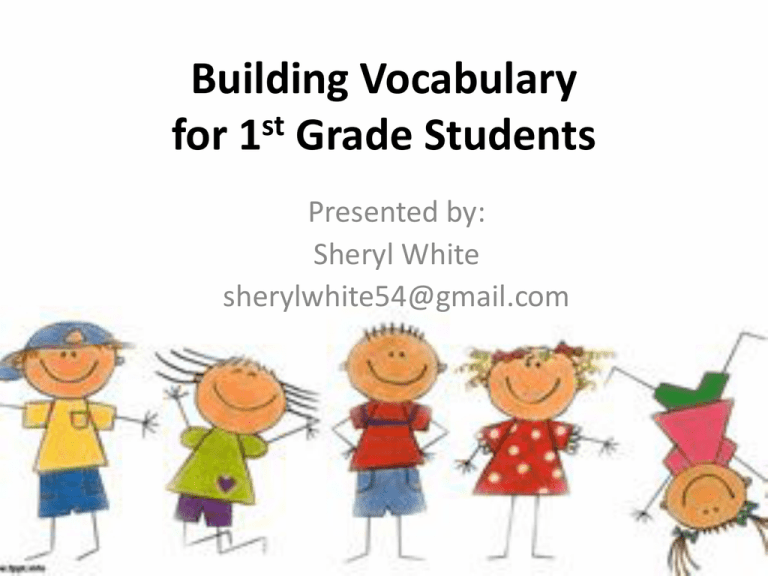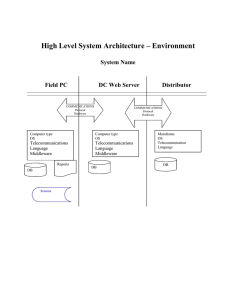Building Vocabulary through Text (Grade 1)
advertisement

Building Vocabulary st for 1 Grade Students Presented by: Sheryl White sherylwhite54@gmail.com Get A Card • Make sure you have a card. • You will sit at the table labeled with the # card you have in your hand. Session Objectives • Understanding vocabulary demands in the Common Core State Standards • Selecting Tier 2 Academic Vocabulary • Examining strategies for teaching vocabulary How much do you know about the 3 tiers of vocabulary? Use a 1 Not heard of three tiers of vocabulary to show your current understanding. 2 Very little knowledge of three tiers of vocabulary 3 Some familiarity of three tiers of vocabulary 4 Know three tiers of vocabulary and how to use 5 Deep knowledge of three tiers … can teach others The Importance of Vocabulary • Vocabulary knowledge is one of the best indicators of verbal ability. • Vocabulary knowledge in kindergarten and first grade is a significant predictor of reading comprehension in the middle and secondary grades. The Importance of Vocabulary • Vocabulary difficulty strongly influences the readability of text. In fact, vocabulary is far and away the most significant factor influencing text difficulty. • Teaching vocabulary can improve reading comprehension for both native English speakers and English learners. (Graves, 2006, 2007) Oral Language & Vocabulary Research Risley, Todd R. Meaningful Differences in Everyday Experience of Young American Children, 1995. Social Status Number of words heard per/hour Estimate of number of words heard per/week Encouraging words vs. Discouraging words per/week Welfare Families 616 62,000 500 vs. 1,100 Children from Working Class Families 1,251 125,000 1,200 vs. 700 Children from Professional Families 2,153 215,000 3,200 vs. 500 Common Core Vocabulary L.1.5 With guidance and support from adults, demonstrate understanding of word relationships and nuances in word meanings. Introduce- Quarter 1 • L.1.5a. Sort words into categories (e.g., colors, clothing) to gain a sense of the concepts the categories represent Develop- Quarter 1 • L.1.5c Identify real-life connections between words and their use(e.g., note places at home that are cozy). Common Core Vocabulary Introduce-Quarter 2 L.1.5.b • Define words by category and by one or more key attributes (e.g., a duck is a bird that swims; a tiger is a large cat with stripes). L.1.5.d • Distinguish shades of meaning among verbs differing in manner (e.g., look, peek, glance, stare, glare, scowl) and adjectives differing in intensity (e.g., large, gigantic) by defining or choosing them or by acting out the meanings. Components of a Successful Vocabulary Program • • • • • High-Quality Classroom Language Reading Aloud to Students Explicit Vocabulary Instruction Word-Learning Strategies Wide Independent Reading High-Quality Classroom Language • Use high quality vocabulary in the classroom. • To ensure understanding, tell students the meaning of words when first used. – “Don’t procrastinate on your work. Procrastinate means to wait to doing something you should be doing.” – Pair in the meaning of the word by using parallel language. “Please refrain from talking. Please don’t talk.” Read-Alouds • Actively engage students during story book and informational text reading to increase vocabulary gains. • Ask questions that promote passage comprehension. Retell and prediction questions are particularly useful. – Use a variety of responses including: • Group (choral) responses • Partner responses • Physical responses 13 Read-Aloud Vocabulary Instruction Instructional Focus Incidental Exposure Example: I don’t know what I would have done. Curiosity might have gotten the better of me. Explanation: Teacher infuses a vocabulary word into a discussion about the read-aloud. Read-Aloud Vocabulary Instruction Instructional Focus Embedded Instruction Example: And he’s using an oar-a stick-to move the raft [pointing to the illustration]. Explanation: Teacher provides a synonym before the target term oar, pointing to the illustration. Read-Aloud Vocabulary Instruction Instructional Focus Focused Instruction Example: Let’s get set means let’s get ready [elicits examples of things students get ready for]. Explanation: Teacher leads a discussion on what it means to, get set including getting set for school and party. Explicit Vocabulary Instruction • Vocabulary activities specifically designed to teach new words • Explicit vocabulary strategies – Use informational and narrative texts – Promote thinking and extend discourse – Encourage use of novel words – Provide access to print – Examine word relationships – Teach word parts – Use graphic organizers 17 Successful Vocabulary Instruction A successful approach to vocabulary instruction involves directly explaining the meanings of words along with thought-provoking, playful and interactive follow-up. Common Core and Three Tiers of Vocabulary Three Tiers of Words Tier One Tier Two Tier Three High Frequency Words Academic Vocabulary Domain-specific Vocabulary 20 Three Tiers of Vocabulary • Tier 1- Everyday Words (implicit) – Used in everyday speech* chair, bed, happy, house (Beck & McKeown, 1985) Three Tiers of Vocabulary • Tier Two - Words in general use, not content specific = Academic Vocabulary Appear far more in written texts than in speech – concentrate, absurd, fortunate, relieved, dignity, convenient, observation, analyze, persistence ++describe, detail, example Three Tiers of Vocabulary • Tier Three- Domain-Specific Words – Words related to a specific content or field of study – triangle, stem, addition, syllable – tundra, igneous, triangle, perpendicular, democracy Explicit Vocabulary Instruction Sources of Words • Sources of Tier 2 words for vocabulary instruction – WORDS from read-aloud books – WORDS from core reading programs – WORDS from reading intervention programs – WORDS from content area instruction and texts • Math • Science • Social studies • Health • Art, PE, music, etc. 24 Sources of Words for Young Children • for the most part ARE NOT words from the texts that young children read • ARE words from books that are read to children • teacher’s and other adult’s language Explicit Vocabulary InstructionSelection of Vocabulary Select words that : • are likely unfamiliar • are critical to passage understanding. • students are likely to encounter in the future and are generally useful. • are Tier Two words (Academic Vocabulary) • are easily explained to children at their level (Beck & McKeown, 2003) (Stahl, 1986) 26 Explicit Vocabulary Instruction Selection of Vocabulary “Goldilocks Words” –Not too difficult –Not too easy –Just right (Stahl & Stahl, 2004) 27 Selection Criteria for Instructional Vocabulary Tier 1 Tier 2 Tier 3 Description Basic words that most children know before entering school Examples clock, baby, happy Words that appear frequently in texts and for which students already have conceptual understanding coincidence, fortunate, insist, adapt Uncommon words that are typically associated with a specific domain or content area chrysalis, peninsula, decimal (Beck, McKeown, Kucan, 2002) How do I determine that a word is TIER Word Is this a generally useful word? Does the word relate to other words and ideas that students know or have been learning? Is the word useful in helping students understand text? 2? If you answer yes to all three questions, it is a tier 2 word. If not, it is probably a tier 3 word. Your Turn-Selecting Tier 2 Words • In partners at your table, choose one of the texts you have brought to work with for today. • Identify (4 )Tier 2 words you would teach your students. • Use the selection criteria to help guide you through this process. What Strategies Would You Use to Teach Your Selected Words? Fold the Line Tier Two Words Handout: Vocabulary Activities Using Tier Two Words • Skim the activities • Pick one you think you would use! Text Talk: Teaching Vocabulary Using Read Alouds • Use books teachers read aloud to students as a source of vocabulary • Engage in vocabulary activities after a book has been read – K-1 recommendation (I. Beck ,M.McKeown & L. Kucan)) Text Talk for Young Children A read-aloud approach to enhance children’s comprehension and vocabulary acquisition. • Introduce the story • Read – Stopping and asking open-ended questions – Following up children's’ response (e.g. rereading, revoicing) • Think and Talk – Comprehension discussion • Explicit Vocabulary Instruction • Extended practice and application Text Talk Explicit Vocabulary Instruction Read story and select 3-6 Tier 2 words. Introduce Vocabulary Step 1: Contextualize each word from text. Step 2: Explain the meaning of the word is explained using student-friendly terms. Step 3: Children repeats the word so they can create a phonological representation of the word. Providing Student-Friendly Definitions Providing student-friendly definitions—ones that are accurate and that students will understand—is no mean task. Below is a definition of dazzling from the dictionary and a student-friendly definition. Beck, McKeown, and Kucan (2003). “bright enough to deprive someone of sight temporarily” “If something is dazzling, that means that it’s so bright that you can hardly look at it.” Cobuild 36 Text Talk Explicit Vocabulary Instruction Introduce Vocabulary Step 4: Teacher provides examples in contexts and other than the one used in the story. Students also provide their own examples. Step 5: Children say the word again to reinforce the phonological representation. Text Talk Explicit Vocabulary Instruction Develop Vocabulary Step 6: Students engage in activities that allow them to interact with words. These activities serve as a means for students to respond, explain and create their own examples. Activities for Interacting with Words • • • • • What’s the Word Concept Web Making Choices Idea Substitution Situations and Examples • Choose the Best Answer • Word Association • Questions, Answers, Reasons • Using All the Words* Interacting with Tier Two Words Study at your table: • Vocabulary Activities Using Tier Two Words • Activities for Interacting with Words My Turn “Ruby the Copycat” • You will be my class! • Please follow along with me and participate in the “student” responses. • coincidence, loyal, murmured Text Talk Maintaining Words The research strongly points to the need for frequent encounters with new words in order to become a permanent part of a student’s vocabulary repertoire. • Apply Words Learned to New Stories • Using Words in Reading and Writing Situations Other Text Talk Extensions Morning Message Word Tallies Our Words # of Times We Have Heard Word reluctant IIII drowsy III loyal IIII Word Jar Word Wall Supporting English Language Learners • In addition to the language-based activities in Text Talk, teachers should shelter instruction by: – Using visuals – Adding motions or acting out words to be learned Your Turn • As a small group, triad or partners, you will practice designing a Text Talk lesson using the a book you brought for today. • Complete the Text Talk Planning template • Choose at least 2 interactive activities Making Vocabulary Active TPR- Total Physical Response • recognizes the value of language being associated with physical responses • grammar-based view of language that focuses on meaning, not form • evidence-based strategy for English Language Learners • scamper strong • peek • forlorn Explicit Vocabulary Instruction Using Literature & Informational Text • Graphics and visuals – Identify the word(s) to be learned – Present a student-friendly explanation – Illustrate the word with examples or have children act out revolve – when something moves around something else Marzano Building Academic Vocabulary Word Blasters • Strategy used after reading with selected Tier 2 words. • Used to prepare students to incorporate words in speaking and writing. http://www.nancyfetzer.com/ Word Masters to Movie Scripts Video Learning Portal Categorizing/Sorting List-Group-Label for Young Children • Identify topic • Provide or have students generate words related to topic or use picture cards that relate to topic • Sort picture cards into group • Label the name for each category Categorizing/Sorting Categories Descriptors • Familiar Settings & Topics – Categories • 5 Senses, etc. • People, Places, Things Your Turn • Each table will be given a card with a topic and type of category • As a group, create a chart that shows how you would teach this topic and categories. Connecting Words to Real Life Identify real-life connections between words and their use (e.g., note places at home that are cozy). • Vocabulary Word: zones • Process: Using the word “zones”, students will identify real-life connections the word’s meaning. They will draw a picture illustrating the kinds of “zones” we have at school. (quiet zones, play zones, work zones) • Evaluation: Oral responses/product Math Tier Two Words Real-Life Connections Family Community Seasons Categorizing/Sorting Semantic Feature Analysis Can modify for Kindergarten students by using pictures on both axis. Semantic Feature Analysis Words and Shades of Meaning • Acting out • Simon Says – talk, march, strut, prance – speak, whisper, murmur Shades of Meaning • Select a specific vocabulary word, e.g., large. • Create a list of semantically similar words. It may work best to think of your target word as being in the center of your continuum. • Arrange the words in a way that illustrates an understanding of each word's meaning. Continuums can be done horizontal or vertical, in a ladder like fashion. • Have students discuss their rationale for placing certain words in certain locations. • Encourage a conversation about the subtle differences among the words. Shades of Word Meaning stroll, wander, trudge, swagger, stride, tread, shuffle, creep A Ladder of Shades of Words humongous gigantic huge massive large big A Bridge One Meaning to Others • Sort words by degrees or shades of meaning using visual cues • Act out (when possible) the different meanings Awake Tired Drowsy Asleep Word Order • Make a list of all of the words that you know mean _(happy)_. • Write or say them in order from weakest to strongest. – Strongest to weakest – angry, cross, furious, grumpy • Making this Happen • With your group, please take time to discuss how you will begin implementation of Common Core explicit vocabulary instruction. • What steps might you take to get started? How much do you know NOW about the 3 tiers of vocabulary? Use a 1 Not heard of three tiers of vocabulary to show your current understanding. 2 Very little knowledge of three tiers of vocabulary 3 Some familiarity of three tiers of vocabulary 4 Know three tiers of vocabulary and how to use 5 Deep knowledge of three tiers … can teach others 3-2-1 Evaulation List 3 Things You Learned: List 2 Things You Will Try: List 1 Question You Have:





